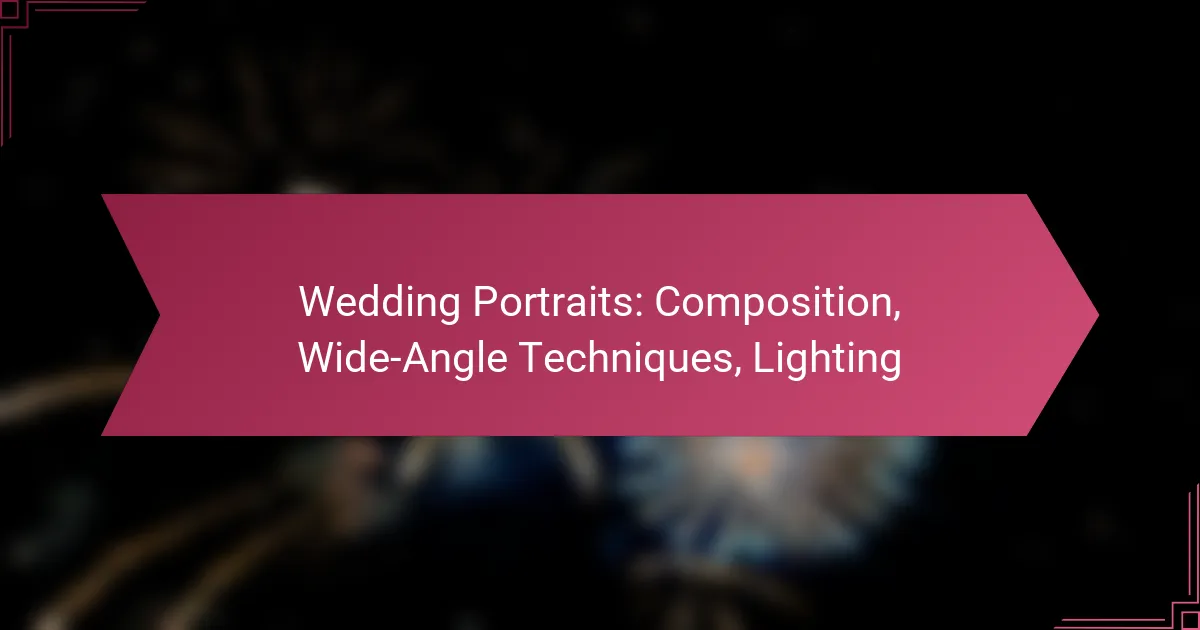Capturing breathtaking wedding portraits involves a keen understanding of composition, wide-angle techniques, and effective lighting. By thoughtfully arranging elements within the frame and utilizing wide-angle lenses, photographers can create immersive images that highlight both the couple and their surroundings. Additionally, mastering the nuances of lighting can significantly enhance the mood and detail of each portrait, resulting in visually stunning memories that last a lifetime.
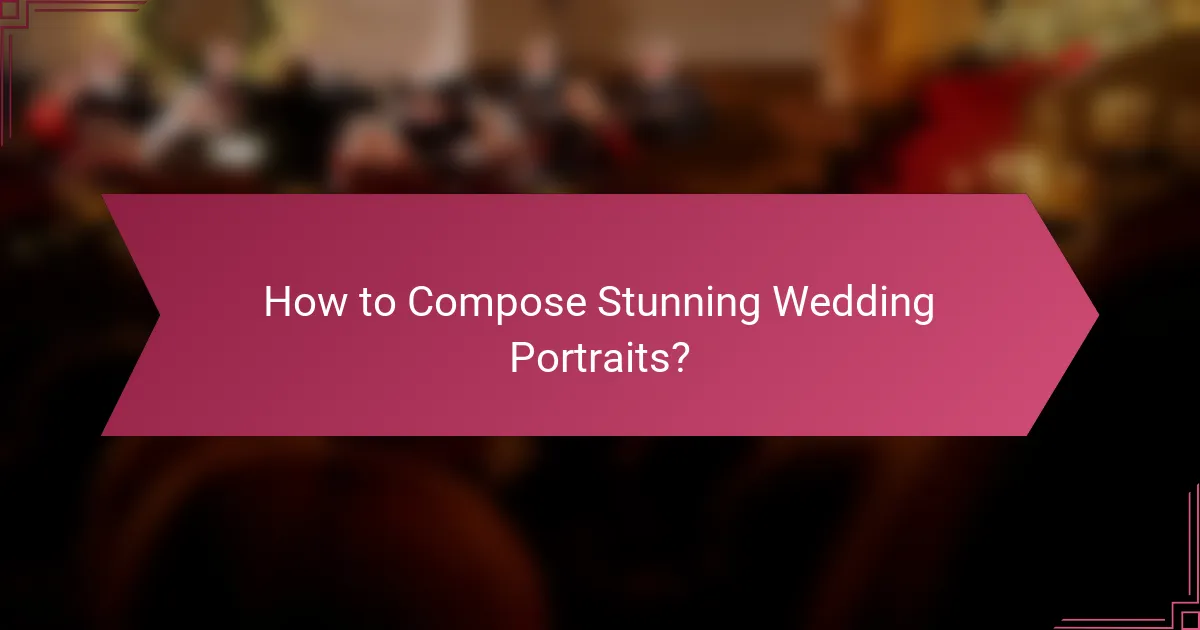
How to Compose Stunning Wedding Portraits?
To compose stunning wedding portraits, focus on the arrangement of elements within the frame, utilizing techniques that enhance visual appeal and storytelling. Key compositional strategies include the rule of thirds, leading lines, framing techniques, symmetry, and depth of field.
Rule of Thirds
The rule of thirds is a fundamental compositional technique that divides the frame into a 3×3 grid. Positioning key subjects along these lines or at their intersections creates balance and draws the viewer’s eye. For wedding portraits, place the couple off-center to add interest and context to the background.
When applying this rule, consider the horizon line and other elements in the scene. For instance, if shooting outdoors, align the couple with the sky or landscape to enhance the overall composition.
Leading Lines
Leading lines guide the viewer’s eye toward the main subject, creating a sense of depth and perspective. Use natural elements like pathways, fences, or architectural features to draw attention to the couple. This technique works well in outdoor settings, where lines can lead from the foreground to the couple in the background.
Be mindful of how these lines intersect with your subjects. Ensure that they complement rather than distract from the couple, maintaining focus on their connection and emotion.
Framing Techniques
Framing involves using elements within the scene to create a ‘frame’ around the couple, enhancing their prominence in the portrait. This can be achieved with trees, arches, or doorways that encircle the subjects. Such techniques add depth and context, making the image more engaging.
When framing, ensure that the frame does not overpower the couple. The goal is to enhance their presence, so choose framing elements that are visually appealing yet subtle.
Symmetry and Balance
Symmetry and balance create a sense of harmony in wedding portraits. Positioning the couple symmetrically within the frame can evoke feelings of stability and unity. This technique is particularly effective in formal settings, such as churches or grand venues.
However, asymmetrical compositions can also be powerful. Experiment with placing the couple off-center while balancing other elements in the frame to maintain visual interest without losing harmony.
Depth of Field
Depth of field refers to the range of distance within a photo that appears sharp. A shallow depth of field, achieved by using a wide aperture, isolates the couple from the background, drawing attention to them. This technique is ideal for capturing intimate moments during the wedding.
Conversely, a deeper depth of field can be used to keep both the couple and the surrounding environment in focus, providing context. Choose your depth of field based on the story you want to tell in the portrait.
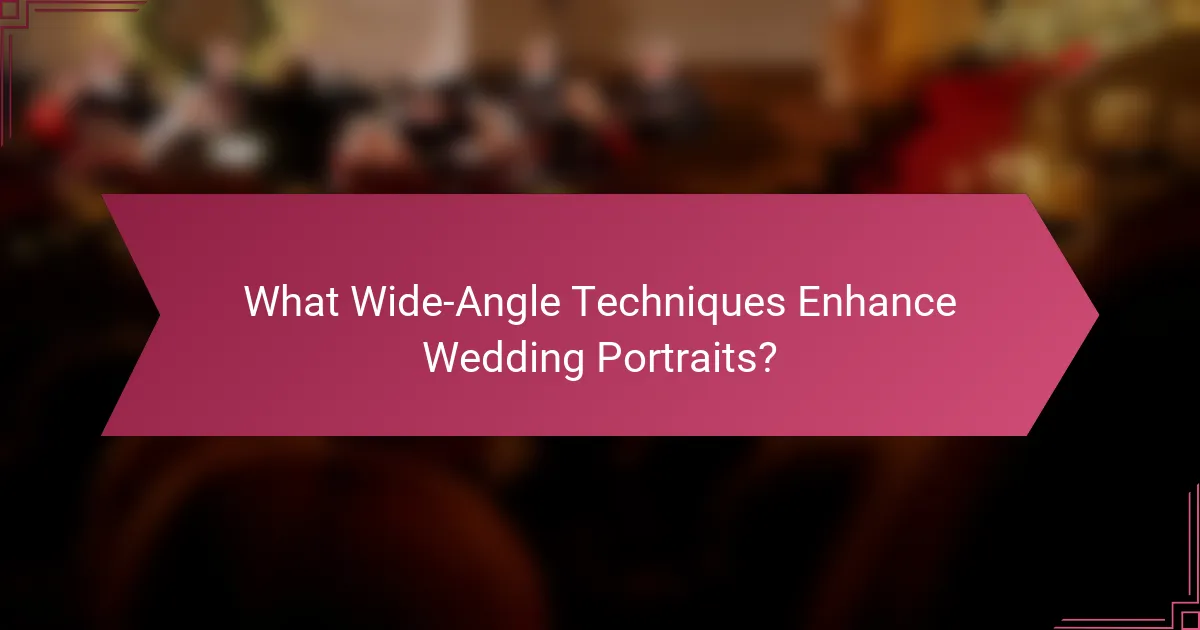
What Wide-Angle Techniques Enhance Wedding Portraits?
Wide-angle techniques can significantly enhance wedding portraits by allowing photographers to capture more of the scene and create a sense of depth. These techniques emphasize the couple and their surroundings, making the images feel more immersive and dynamic.
Using Wide-Angle Lenses
Wide-angle lenses, typically ranging from 14mm to 35mm, are essential for capturing expansive backgrounds and large groups. They allow photographers to fit more into the frame without stepping back too far, which is particularly useful in tight venues or outdoor settings.
When using wide-angle lenses, be mindful of distortion, especially at the edges of the frame. To minimize this effect, position your subjects away from the corners and focus on the center of the image. This technique helps maintain a natural look while still benefiting from the lens’s expansive view.
Capturing Group Shots
Wide-angle techniques excel in group shots, making it easier to include everyone in the frame without sacrificing detail. Position the group in a semi-circle or staggered formation to enhance visibility and create a more engaging composition.
To avoid distortion, ensure that the camera is level and not too close to the subjects. A distance of about 10 to 15 feet is often ideal, allowing for a balanced perspective while keeping everyone in focus. This approach helps maintain a flattering appearance for all participants.
Creating Dramatic Perspectives
Wide-angle techniques can create dramatic perspectives by emphasizing foreground elements and drawing the viewer’s eye into the scene. By placing an interesting object close to the lens, you can enhance the sense of depth and scale in your portraits.
Experiment with angles and heights to find the most compelling compositions. Shooting from a low angle can make the couple appear larger than life, while a high angle can provide a unique overview of the setting. Always consider the background to ensure it complements the subjects and enhances the overall narrative of the portrait.
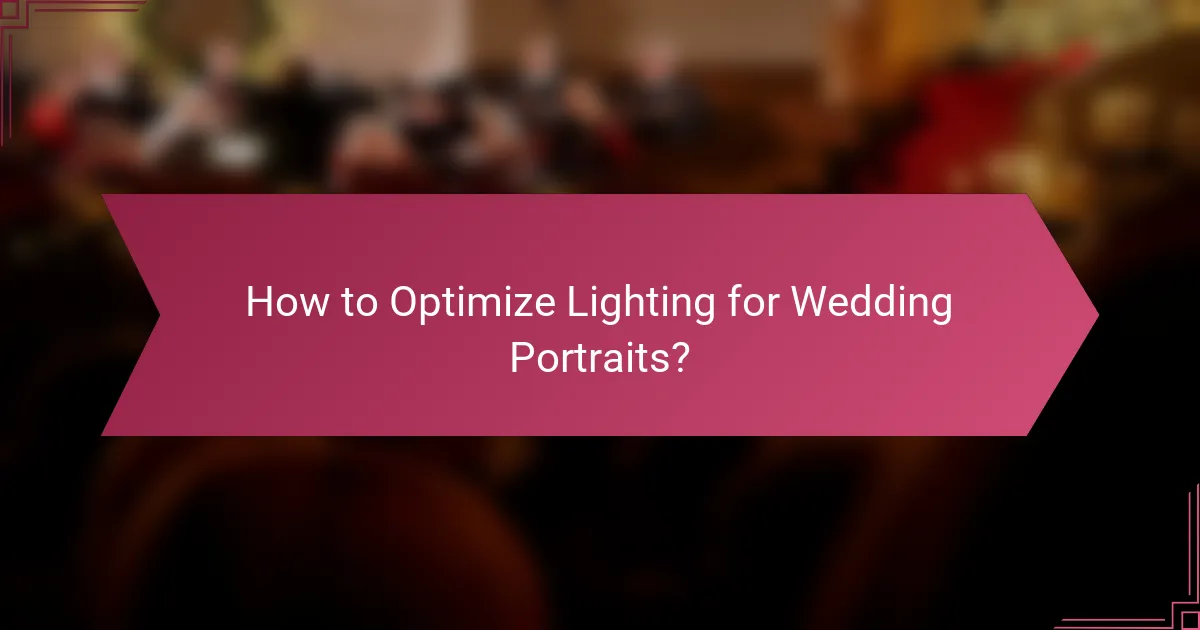
How to Optimize Lighting for Wedding Portraits?
To optimize lighting for wedding portraits, consider the quality, direction, and source of light. Effective lighting enhances the mood and details in portraits, making them more visually appealing.
Natural Light Techniques
Utilizing natural light can create soft, flattering portraits. Position your subjects near windows or outdoors in shaded areas to avoid harsh shadows and overexposure. The time of day significantly affects the quality of natural light, so plan your shoots accordingly.
When shooting outdoors, consider using reflectors to bounce light onto your subjects, filling in shadows and adding dimension. This technique is particularly effective during midday when the sun is high.
Using Off-Camera Flash
Off-camera flash allows for greater control over lighting in wedding portraits. By positioning the flash away from the camera, you can create dramatic effects and highlight your subjects more effectively. Experiment with different angles and distances to find the most flattering setup.
Using a softbox or diffuser with your off-camera flash can soften the light, reducing harshness and creating a more natural look. Be cautious of overexposing your subjects; adjust the flash power as needed to maintain balance.
Golden Hour Benefits
The golden hour, occurring shortly after sunrise and before sunset, provides warm, diffused light ideal for wedding portraits. This time of day enhances skin tones and creates a romantic atmosphere, making it a favorite among photographers.
Plan your portrait sessions around this time for the best results. The soft light reduces the need for additional lighting equipment, and the stunning backdrop can add depth to your images. Keep in mind that the duration of the golden hour varies by season, so check local sunset times to maximize your shooting window.
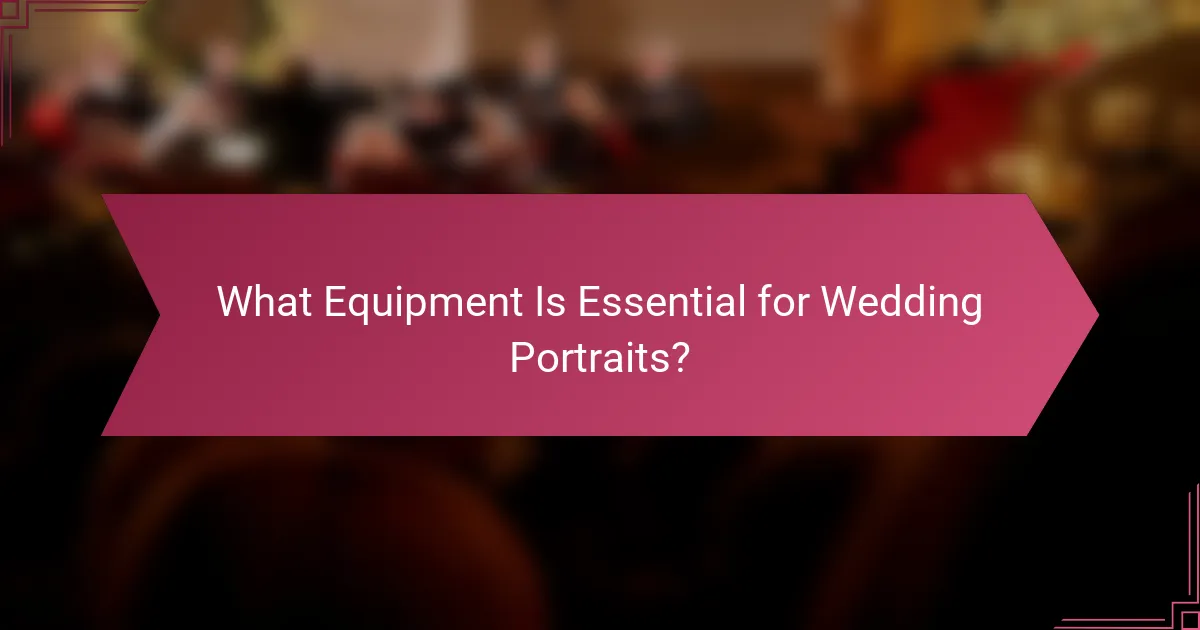
What Equipment Is Essential for Wedding Portraits?
Essential equipment for wedding portraits includes a reliable camera, suitable lenses, and effective lighting gear. These tools help capture high-quality images that reflect the couple’s special day and the emotions involved.
Cameras for Portrait Photography
For wedding portraits, a full-frame DSLR or mirrorless camera is ideal due to its superior image quality and low-light performance. Look for models that offer fast autofocus and a good burst shooting rate to capture fleeting moments.
Consider cameras with weather sealing if you anticipate outdoor shoots in varying conditions. Popular choices include the Canon EOS R series and the Nikon Z series, which provide excellent performance for portrait photography.
Recommended Lenses
A prime lens with a wide aperture, such as a 50mm f/1.8 or an 85mm f/1.4, is highly recommended for wedding portraits. These lenses create beautiful bokeh and allow for sharp focus on the subjects while softly blurring the background.
Zoom lenses, like a 24-70mm f/2.8, offer versatility for different compositions and settings throughout the event. Choose lenses based on the specific style of portraits you want to achieve, whether candid or posed.
Lighting Gear Options
Natural light is often preferred for wedding portraits, but having artificial lighting options is crucial for indoor or low-light situations. A portable flash or speedlight can help illuminate subjects without harsh shadows.
Consider using softboxes or reflectors to diffuse light and create a flattering effect on the couple. Battery-powered LED lights are also a great option for adding creative lighting effects during evening receptions.
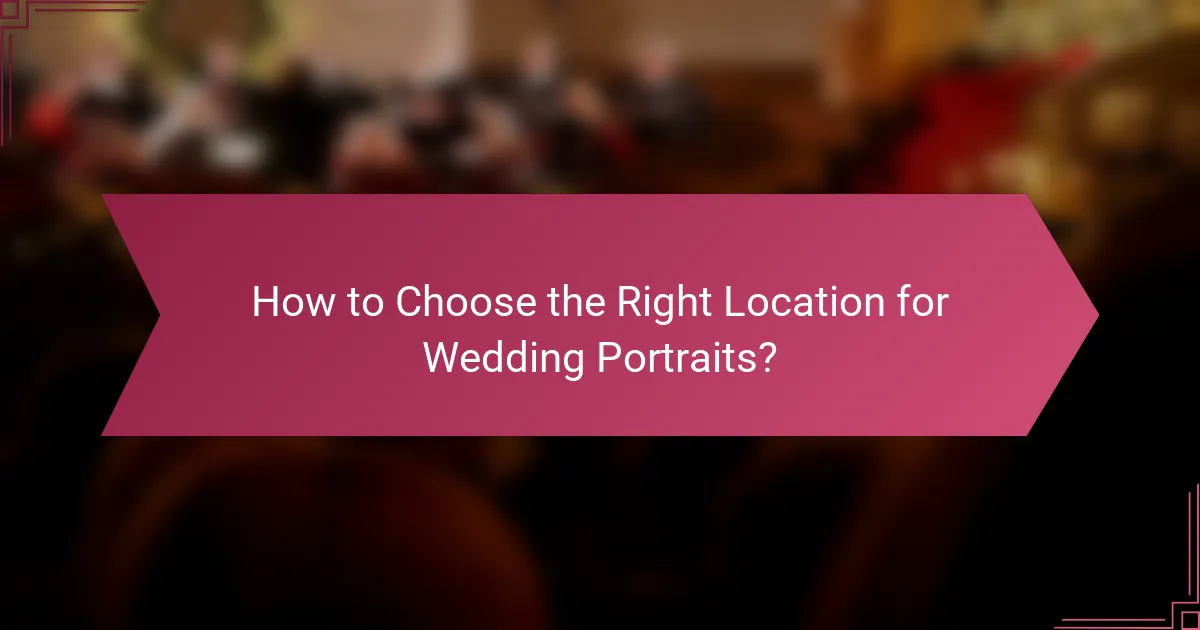
How to Choose the Right Location for Wedding Portraits?
Choosing the right location for wedding portraits involves considering the couple’s style, the season, and the available light. Ideal locations should enhance the couple’s story while providing a beautiful backdrop that complements their attire.
Popular Outdoor Venues
Outdoor venues are favored for wedding portraits due to their natural beauty and versatility. Common choices include gardens, beaches, and parks, each offering unique scenery and lighting conditions.
Gardens often provide vibrant flowers and lush greenery, making them perfect for spring and summer weddings. Beaches offer stunning sunset views and a relaxed atmosphere, ideal for couples who enjoy coastal settings. Parks can be versatile, featuring open spaces, wooded areas, and picturesque paths.
When selecting an outdoor venue, consider the time of day for optimal lighting. Early morning or late afternoon often yields the best natural light, enhancing the overall quality of the portraits. Always check for any necessary permits or regulations that may apply to photography in public spaces.
